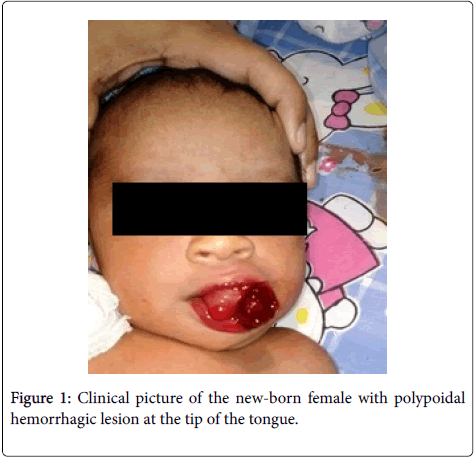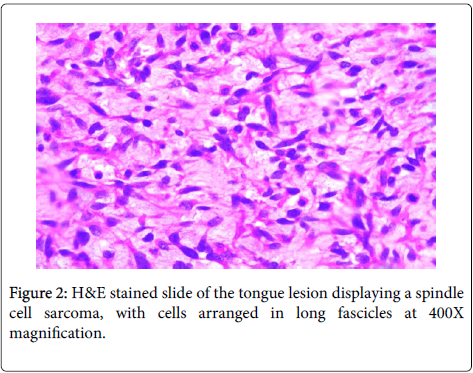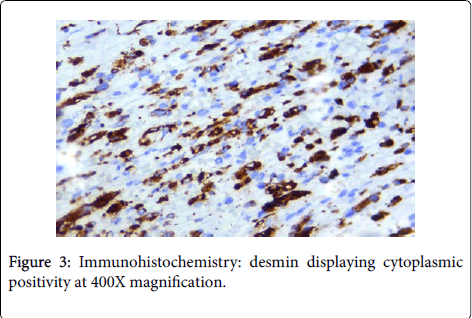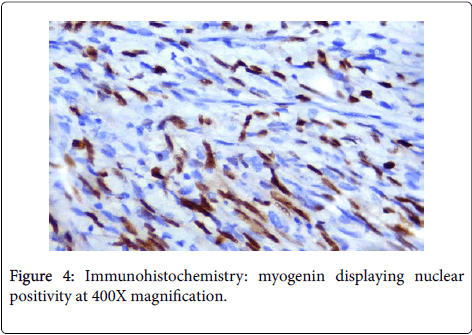Congenital Spindle Cell Rhabdomyosarcoma of Tongue: Rare Presentation as an Acute Emergency
Received: 17-May-2016 / Accepted Date: 10-Jun-2016 / Published Date: 13-Jun-2016 DOI: 10.4172/2161-0681.1000278
Abstract
Rhabdomyosarcomas (RMS) comprise the largest category of soft tissue sarcomas in pediatric population. RMS is the third most common solid tumor in children and about 30-40% arises from the head and neck region. Nearly 30-40% of the head and neck RMS arise from intraoral and pharyngeal structures, but involvement of the tongue by this tumour is extremely rare. About 4% of embryonal rhabdomyosarcoma affect infants and few cases are congenital. Most RMS of the tongue are reported to be of embryonal histology, although there are cases diagnosed with alveolar or undifferentiated RMS. Spindle cell rhabdomyosarcoma is a rare subtype constituting 5-10% of all cases of rhabdomyosarcomas. Congenital spindle cell RMS of tongue presenting with an acute onset of bleeding is extremely rare. A new-born female was referred to our institute (SRM Institutes for Medical Science, Chennai, India) for management of a tongue lesion, for which basic hematological and biochemical investigations were done. The patient developed sudden onset of severe bleeding from the lesion and emergency excision of the lesion was done under anesthesia and a diagnosis of spindle cell rhabdomyosarcoma was made, following routine histopathology and immunohistochemistry. Post-operative period was uneventful.
Keywords: Rhabdomyosarcoma; Tongue; Congenital
Introduction
Rhabdomyosarcomas (RMS) is the third most common solid tumor in children and about 30-40% arises from the head and neck region [1,2]. Nearly 30-40% of the head and neck RMS arise from intraoral and pharyngeal structures, but involvement of the tongue by this tumour is extremely rare [3]. The intergroup rhabdomyosarcoma study committee reports I, II and III recorded only 7 cases of primary rhabdomyosarcoma of tongue in children and adolescence which represented 0.34% of all cases [4]. Traditionally, spindle cell RMS was included as a variant of embryonal RMS, but it is now provisionally listed as a separate subtype according to WHO classification of soft tissue tumours, 2013.
Case History
Twenty four year old female was admitted elsewhere for elective lower segment caesarean section with an indication of oligohydramnios. A female term baby was delivered with an Apgar score of 8/10 at 1 minute and 9/10 at 5minutes. The baby was small for gestational age weighing 2.56 kg. On examination, a globular swelling with ulceration at the tip of the tongue measuring 3 × 2cm was noted. No other obvious congenital abnormalities were seen (Figure 1).
Differential diagnosis of hemangioma and teratoma were considered and the case was referred to our institute (SRM Institutes for Medical Science, Chennai, India) for further management. The case was planned for an elective surgery after appropriate imaging. The baby developed sudden onset of profuse bleeding from the lesion and was taken for emergency excision. Preoperative investigations including complete hemogram, coagulation profile and renal function tests were unremarkable. The lesion was excised in to under general anesthesia and sample was sent for histopathological examination.
Macroscopically, it was a fairly circumscribed tumor covered partly by mucosa with surface ulceration and hemorrhage. Cut surface revealed myxoid areas. Microscopically, the tumor was composed of spindle shaped neoplastic cells arranged in large intersecting fascicles. The cells had ovoid to elongated nuclei, vesicular chromatin and pale eosinophilic cytoplasm. Mild to moderate nuclear atypia, hyperchromasia and brisk mitotic activity were noted. Foci of myxoid change, vascular congestion and hemorrhage were seen. Immunohistochemistry revealed positivity for vimentin, desmin, myogenin and SMA (focal), while negative for S100 and a diagnosis of spindle cell rhabdomyosarcoma was made (Figure 2).
Discussion
Rhabdomyosarcomas comprise the single largest category of soft tissue sarcomas in children and adolescents, with 4.5 cases per million persons aged 0-20years in USA and is more common in males. Children aged <10 years are typically affected with most cases (36%) occurring in <5 years (Table 1) [5].
| IRSC Group | Definition |
|---|---|
| I | Localized disease, complete resection |
| II | Microscopic residual disease |
| III | Gross residual disease |
| IV | Distant metastasis |
Table 1: The Intergroup Rhabdomyosarcoma Study Committee Classification.
Rhabdomyosarcoma can be divided into embryonal, alveolar, pleomorphic & spindle cell/sclerosing types. Spindle cell rhabdomyosarcoma is an uncommon variant affecting both children and adults, the most commonly involved sites being paratesticular region in pediatric population and deep soft tissue in head and neck in adults. Rarely involved sites include viscera and retroperitoneum [6]. Congenital rhabdomyosarcoma is seen in 1-2% of all cases and can be diagnosed at birth or in the first 28 days [7]. The common sites involved in oral cavity are oropharynx and base of tongue, but none from the tongue itself according to the largest series of RMS from the Children’s Cancer Chemotherapy Study Group [2]. The Intergroup Rhabdomyosarcoma Study Committee classification (IRSC) has four surgical and pathologic grouping system, which categorize patients according to the extent of residual disease following surgery, but before beginning chemotherapy and radiation (Figure 3) [8].
RMS of the tongue is very rare and few cases have been reported in the English literature. Liebert and Stool have reported the first case of rhabdomyosarcoma of tongue in 1973 [9]. In a study from M.D. Anderson Cancer Center, between 1944 and 1984, only 1 out of 16 patients with RMS of the oral cavity had RMS of the tongue [10]. Spindle cell rhabdomyosarcoma involving the tongue in a new born is extremely rare and only one case has been reported in 2004, which had similar histomorphology to the present case [11]. The differential diagnosis in our case was infantile fibrosarcoma, which was ruled out by immunohistochemistry (Figure 4).
The treatment is multimodal, comprising of surgery, chemotherapy and brachytherapy, which is based on the size and site of the lesion and associated morbidity [8,9]. Children with spindle cell RMS have a favorable outcome, with 95% survival at 5years, whereas adults have a significantly worse prognosis [5,12].
The interesting finding in the present case is the manifestation of the lesion as an acute emergency in a new-born. A clinical diagnosis of the hemangioma was made owing to the sudden onset of profuse bleeding from the lesion, which is an extremely uncommon presentation in rhabdomyosarcomas. Post-operative period was uneventful and the case was referred to the oncology department, following which the infant was treated with chemotherapy. Following two cycles of chemotherapy, the child succumbed due to bronchopneumonia.
References
- ShoumanT, Kest IE, Zaza K, Ezzat I(2005) Rhabdomyosarcoma in childhood: A retrospective analysis of 190 patients treated at a single institution. J Egypt Natl cancer Inst 17:67-75.
- Gurung U, Srivastav A, Guragain R, Bhusal CL(2011) Congenital rhabdomyosarcoma of tongue in newborn. Nepal J ENT Head Neck Surg 2:15-16.
- Gupta SN, Gangopadhyay AN, Khanna S(1990) Congenital rhabdomyosarcoma of the tongue. PediatrSurgInt 5:284-286.
- Skelton VA, Goodwin A(1999) Perinatal management of a neonate with airway obstruction caused by rhabdomyosarcoma of the tongue. Br J anaesth 83:951-955.
- Ognjanovic S, Linabery AM, Charbonneau B,Ross JA(2009) Trends in childhood rhabdomyosarcoma incidence and survival in the United States, 1975-2005. Cancer115:4218-4226.
- Cavazzana AO, Schmidt D, Ninfo V, Harms D, Tollot M, et al. (1992) Spindle cell rhabdomyosarcoma. A prognosticallyfavorable variant of rhabdomyosarcoma. Am J SurgPathol 16: 229-235.
- Ferrari A, Casanova M, Bisogno G,Zanetti I, Cecchetto G, et al. (2003) Rhabdomyosarcoma in infants younger than one year old; a report from Italian Cooperative Group. Cancer 97:2597-2604.
- Childs LF, Goudy SL (2009) Congenital rhabdomyosarcoma of the tongue: A case report. Int JPediatrOtorhinolaryngol Extra 5: 126-128.
- Liebert PS, Stool SE(1973) Rhabdomyosarcoma of the tongue in an infant: results of combined radiation and chemotherapy. Ann Surg 178:621-624.
- Bras J, Batsakis JG, Luna MA(1987) Rhabdomyosarcoma of the oral soft tissues. Oral Surg Oral Med OralPathol 64:585-596.
- Gupta A, Maddalozzo J, Htin TW, Shah A, Chou PM (2004) Spindle cell rhabdomyosarcoma of the tongue in an infant:a case report with emphasis on differential diagnosis of childhood spindle cell lesions. Pathology Research and Practice 200: 537-543.
- Leuscher I, Newton WA, Jr Schmidt D, Sachs N, Asmar L, et al. (1993) Spindle cell variants of embryonal rhabdomyosarcoma in the paratesticular region. A report of the Intergroup Rhabdomyosarcoma Study. Am J SurgPathol 17:221-230.
Citation: Balasundaram P, Kumaresan K, Sathyanarayana MV, Sateesh M (2016) Congenital Spindle Cell Rhabdomyosarcoma of Tongue: Rare Presentation as an Acute Emergency. J Clin Exp Pathol 6:278. Doi: 10.4172/2161-0681.1000278
Copyright: © 2016 Balasundaram P, et al. This is an open-access article distributed under the terms of the Creative Commons Attribution License, which permits unrestricted use, distribution, and reproduction in any medium, provided the original author and source are credited.
Share This Article
Open Access Journals
Article Tools
Article Usage
- Total views: 13281
- [From(publication date): 6-2016 - Apr 25, 2024]
- Breakdown by view type
- HTML page views: 12501
- PDF downloads: 780




